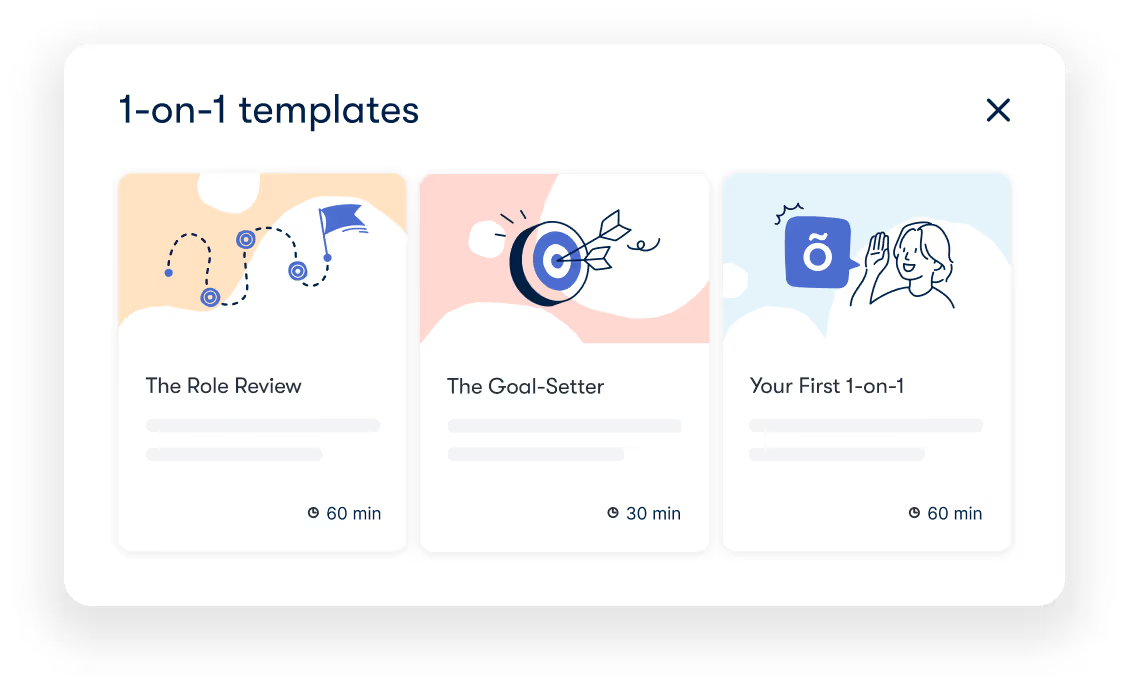5 ways to ensure team & goals alignment to improve performance

Discover Workleap Officevibe's benchmark report on 12 key employee engagement metrics

Whether you're managing a two-person operation or a department of 100, it's nearly impossible for your organization to grow and move on to the next chapter of success if your whole team isn't on the same page.
Teams are at their best when they work cohesively and rally around shared goals. To help you reach better team alignment, we've broken down what team alignment means, why it's important – especially in a remote context – and actionable tips to help you move forward together.
What is team alignment?
Alignment in the workplace occurs when all team members have a better understanding of company goals and have a clear vision for collective (and individual) long-term success. It isn't enough to know the end destination; you need to all be rowing in the same direction.
But team alignment extends beyond bottom line objectives; employees must all be on the same wavelength when it comes to achieving and building sustainable business practices. It's one thing for everybody to understand what you hope to achieve as a company, but ensuring your team is aligned with company values plays a crucial role in an organization's success. This requires people to believe in the approach and understand the role they and their colleagues collectively play.
5 Ways to foster strong team alignment
Let's dive into some helpful ways you can foster strong team alignment within your business.
1. Make communication and transparency core organizational values
How well you communicate information at every level of your organization will play a major role in fostering team alignment. It's so easy to fall into information silos, especially in a remote context where many team members are working in their own physical spaces.
If you have major organizational news or project updates to communicate, don't leave your team members in the dark; make sure to carve out some time where you can answer employee questions and clear up any confusing tidbits of information. The more transparent you are, the more aligned your team will be.
2. Set crystal clear goals for your team
The goals you set for your team will be your North Star in helping your organization achieve success. Without clear objectives, the big picture can get lost in the shuffle of daily operations.
But you might be asking yourself: what is the most surefire way to document your goals? Team alignment looks different for every company, so there's no one-size-fits-all solution. If you're looking for a tried and true approach, the OKR goal-setting framework might be for you.
OKR stands for ‘Objectives and Key Results.’ The whole approach centers on establishing a clear goal (objective) and the metrics (key results) that will measure that goal’s success. Company OKRs empower managers to set goals together with their teams, and from there, set individual goals for every team member. This creates an aligned workforce that is better equipped to achieve broader business goals by tackling them one at a time.
One final (and super important) tip about goal-setting: involve your team. When everyone is involved in setting team goals, they're more likely to support them, understand them, and remember them.
{emphasize}
💡Sign up for Officevibe's OKR email course where you'll learn the ins and outs of setting (and achieving!) stand-out company goals.
{emphasize}
3. Check in with your team regularly
Communication around your company's values, strategy, and major objectives should not be one-sided. While it's important to keep your team in the loop from the top down, it's just as fruitful to uncover how these things are being understood and come to life on the front line.
So, once you've shared company objectives with your team and helped them set their own OKRs, how can you maintain a communication loop around alignment?
{emphasize}
- Book quarterly strategy meetings to clearly map out the connection between organizational, team, and individual goals. This can also be a good setting to discuss shifts in priorities or any possible tweaks to existing objectives.
- Encourage anonymous feedback and messaging where employees can pose questions or raise any thoughts or concerns they may have. Having an anonymous touchpoint can help some employees feel more comfortable giving their candid feedback around alignment.
- Carve out one-on-one time to discuss alignment with individual team members. Give them the time and space to ask anything that may be unclear about their specific objectives or how their role contributions to the broader picture.
- Send weekly surveys with both quantitative and qualitative questions to measure your team alignment metric and keep track of trends over time.
{emphasize}
4. Find the right team alignment tools
A recent study found that the average enterprise now uses an astounding 288 different SaaS apps. These tools are great for keeping us organized and on track and they're especially helpful for distributed teams. But with so many tools comes the potential for information silos and hidden work – both of which can wreak havoc on your team alignment.
The solution isn't to try to force people onto a single tool. It's to identify the key tools that will help you build and achieve team alignment while allowing employees to work how they're most comfortable.
Thankfully, there's no shortage of options.
{emphasize}
- An employee engagement platform like Officevibe empowers business leaders to spearhead alignment strategies. From goal-setting and one-on-one meetings to Pulse Surveys that keep track of how teams are feeling in their day-to-day, Officevibe covers all the bases to boost the employee experience, improve employee satisfaction, and keep teams aligned.
- Chat tools like Slack and Microsoft Teams help keep your team aligned by opening up easy communication channels between employees, regardless of their physical location.
- Project management tools like Trello and Asana can help nip misalignment issues in the bud by ensuring that everybody knows exactly what they need to be working on, and what their team members are working on.
{emphasize}
5. Highlight team accomplishments
Whether you're congratulating your team for a job well done on a new campaign or giving kudos to an employee who reached their one-year workaversary, shining a light on employee contributions and milestones goes a long way in improving team alignment.
But not everyone is comfortable with a public shoutout; some team members may relish the spotlight, while others might prefer a private message from their managers or peers. With Officevibe's recognition platform, you can make sure no good deed goes unnoticed and send your colleagues a Good Vibe to let them know that you appreciate them.
The importance of team alignment in the workplace
Team alignment has a significant impact on the overall performance of your business. Without clear communication on your organization's goals and shared company values, your team members might find it challenging to present a united front and stay engaged.
On the flip side, there are countless benefits to strong team alignment.
{emphasize}
- Aligned teams perform better. Misaligned teams may spend more time going back and forth on specific initiatives and may not be able to perform to the best of their abilities.
When teams are aligned, they're set up to succeed. Everyone has the information they need to make the right decisions, work swiftly, and prioritize projects that contribute to broader company goals. - Aligned teams are more engaged. When your team is aligned, each individual member understands the importance of their role and the roles of their colleagues and believes in the team vision. This creates a sense of camaraderie and belonging. People feel as though they're part of a collective in which everybody is working towards the same thing.
- Aligned teams are more collaborative. It's a lot easier to collaborate when you're coming at a problem with a shared outcome in mind. People are more willing to compromise and support one another if they're all aligned on the desired outcome and what it takes to get there.
{emphasize}
Signs of aligned vs. misaligned teams
According to Officevibe data, 75% of employees wish that their manager could define more precise goals. A team lacking in alignment is like a shopping cart with one bad wheel: it's frustrating and it's a lot harder to move in the right direction.
Here are a few telling signs that can help you find out where your team is on the alignment spectrum.
Beyond these signs, one of the best ways for you to determine whether or not your team is aligned is to ask them. Don't overthink it! Use one of Officevibe's free downloadable one-on-one meeting templates to ask more specific questions and dive into potential reasons for the lack of team alignment.

How remote work affects team alignment
Building and maintaining team alignment is no small feat and the reality of a distributed workforce throws a whole new set of challenges into the mix.
- Many companies and managers are still adjusting to this new work environment, and their teams have fallen out of alignment during the shift. This readjustment period is normal, but it's important to track where schisms may have arisen.
Tip: Log where you feel your team has been compromised by change, so you can implement intentional solutions. - Remote work makes it more challenging to have impromptu conversations and other interactions that help with team alignment.
Tip: Check in on your team and keep your channels of communication open and honest. - Managers of distributed teams often feel they've lost visibility on their teams and are unsure if their employees are focused on the right thing. They may struggle to maintain team alignment as a result.
Tip: Losing visibility can result in the tendency to micromanage. Instead, ask to join in on your team's dailies to keep up to date or hold weekly update meetings for the team to fill you in on progress and setbacks in an open discussion.
Not sure if you're a micromanager? Use this free template to see if you need to reassess your management style. - Finally, in a remote context, the negative impacts of misalignment – both performance-related and emotional – are amplified since issues cannot be resolved face-to-face and have become bucketed with other sentiments of isolation, disconnection, and loneliness.
Tip: Create a safe space in virtual one-on-one meetings dedicated to discussing personal and professional difficulties. Reassure your peers that their feelings of uncertainty or frustration are valid by sharing and searching for solutions together.
How Officevibe can help improve team alignment
Team alignment isn't something that you build and then stop working on. You need to be constantly communicating and engaging with your team to make sure goals and expectations are clear to improve employee satisfaction. This is especially true during times of change.
Officevibe puts people first and empowers managers to plan for growth and success on an individual and company-wide level with intuitive one-on-one meeting tools and templates, a built-in peer recognition platform, and an anonymous feedback channel where employees can speak freely. Officevibe helps you improve team alignment and work toward collective goals while elevating your overall employee experience.
The benefits of having an aligned team are immense: more efficiency, more team collaboration, and higher performance. You can crush your goals while keeping your team happy and engaged. That's something worth investing in.
Give HR and managers the clarity, confidence, and connection to lead better every day.


%20(1).avif)


.avif)
.avif)








